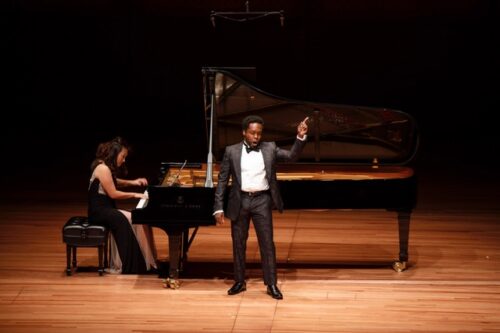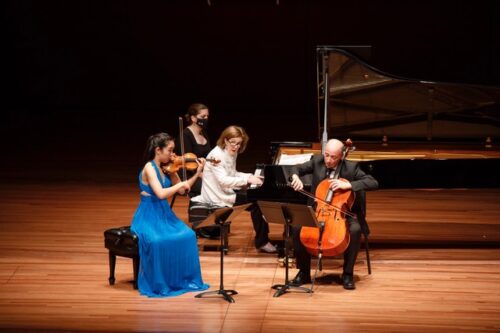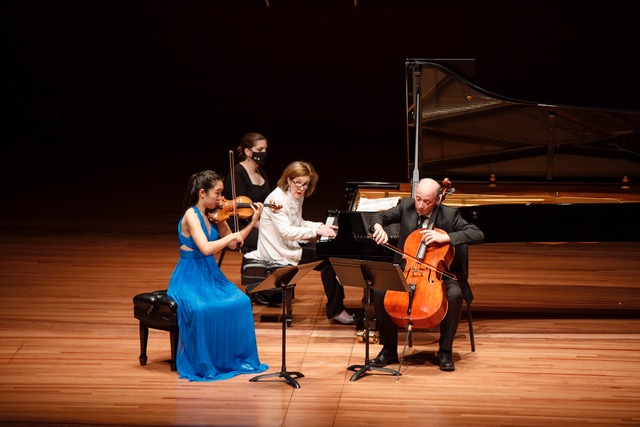 United States Various, ‘Spanish Inspirations’: Chamber Music Society of Lincoln Center (Will Liverman [baritone], Paul Huang & Danbi Um [violins], Paul Neubauer [viola], Nicholas Canellakis & Clive Greensmith [cellos], Anne-Marie McDermott & Wu Qian [piano]). Alice Tully Hall, New York, 14.11.2021. (RP)
United States Various, ‘Spanish Inspirations’: Chamber Music Society of Lincoln Center (Will Liverman [baritone], Paul Huang & Danbi Um [violins], Paul Neubauer [viola], Nicholas Canellakis & Clive Greensmith [cellos], Anne-Marie McDermott & Wu Qian [piano]). Alice Tully Hall, New York, 14.11.2021. (RP)

Boccherini – Quintet in E major for Two Violins, Viola and Two Cellos Op.11 No.5, G.275
Ravel – Don Quichotte à Dulcinée
Turina – Quartet in A minor for Piano, Violin, Viola and Cello Op.67
Shostakovich – Spanish Songs for Voice and Piano Op.100
Cassadó – Trio in C major for Piano, Violin and Cello
Sarasate – Navarra for Two Violins and Piano Op.33
The Chamber Music Society of Lincoln Center should be careful. Too many concerts like ‘Spanish Inspirations’ and word might get out that chamber music is fun. The melodies, moods and rhythms of Spain were delightful in themselves, but the flare and enthusiasm with which the musicians performed lifted the spirits of everyone in the hall.
The concert began with Luigi Boccherini’s Quintet in E major. Although he was born in Italy, Boccherini moved to Spain when he was eighteen and spent the rest of his life there. Composed in 1771, the quintet is one of his most popular works, and its minuet has achieved stand-alone fame. Violinists Paul Huang and Danbi Um, violist Paul Neubauer and cellists Nicholas Canellakis and Clive Greensmith caressed Boccherini’s gentle melodies in an elegant, stylish performance.
Baritone Will Liverman and pianist Wu Qian explored the lure of Spain for twentieth-century composers beyond its borders. Maurice Ravel was born in the western Pyrenees, and his mother spent her childhood in Madrid, so he was no stranger to the sounds of Spain. The three songs that comprise Don Quichotte à Dulcinée were composed as part of a film project that never came to fruition; they were the last works that Ravel completed before his death in 1937.
Ravel captured the lover, dreamer and world-weariness of Cervantes’ famous creation in his music, as did Liverman in his performance of the songs. When singing of love or praying, there was true beauty in Liverman’s voice and a wistfulness that mirrored the dreamer in Don Quixote. He floated the final notes of the first two songs effortlessly but, when called for, he can put a gravelly edge to his voice that adds depth and character. The final drinking song was understated, with Liverman affecting a contained demeanor of self-satisfied inebriation that lent just the right touch of farce.
Shostakovich composed his Spanish Songs at the request of mezzo-soprano Zara Dolukhanova, who was considered one of the Soviet Union’s most accomplished singers from the 1940s through the 1960s. Apart from the attraction of the warmer climes of Iberia, Shostakovich, like many Russians, was sympathetic to the Spanish Communists who had been defeated in the Spanish Civil War. Those sensibilities carry over into his settings of Russian translations of Spanish poems, in which he captures flamenco rhythms, imitates the strumming of the guitar and evokes folk dances, all with an unmistakable Slavic flavor.
Liverman seized the mood and spirit of each song, from the energetic, grand ‘Farewell, Granada!’ to the soft pleas for love in ‘The Black-Eyed Girl’. He was at his dramatic best in the straightforward declamatory delivery which Shostakovich often employed in the songs, although there was a jaunty lightness to ‘Little Stars’ which injected the right amount of sly humor into the song.
As in Ravel’s colorful piano accompaniments, Wu Qian summoned up the music of Spain with sensitivity to the ever-changing moods in the Shostakovich songs. She plays with passion and energy, which served both the composers and Liverman well.
Although his father was Italian, Joaquín Turina was born in Seville, and his vibrant music was influenced by the sights and sounds of his native Andalusia. In the Quartet in A minor, completed in 1931, delicate emotions and high drama are depicted in brilliant solo turns in the instruments. In this performance by Wu Qian, Huang, Neubauer and Canellakis, the ensemble work was precise and polished and the solos dispatched with flare. Most special were the grand moments, when the Andalusian steppes seemed to appear before your eyes.

Perhaps better known as a cellist, Gaspar Cassadó – Pablo Casals offered him lessons after hearing the nine-year-old play – was a composer too. Written in 1926, his Piano Trio in C is typical of his embrace of Spanish folk music with its lively dance rhythms, ornamentation and strings summoning the strumming of the guitar. Violinist Danbi Um and cellist Clive Greensmith played with all the virtuosity and energy for which one could hope, but pianist Anne-Marie McDermott made the work come alive. Her joy filled the hall.
McDermott brought the same high spirits to Pablo de Sarasate’s Navarra, but the nineteenth-century Spanish violin virtuoso also knew how to dazzle with his instrument. To the audience’s delight, Paul Huang and Danbi Um soared through this tour de force for two violins with impassioned melodies and rhythms that brim with the sounds of Spain.
Rick Perdian
To view the Chamber Music Society of Lincoln Center’s Digital Encore: ‘Spanish Inspirations’ click here.
